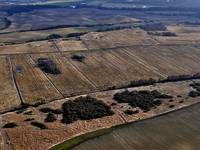Open sedge marshlands - multitalents of the landscape
The habitat of open sedge marshlands is a great feature in many ways. Since the last ice age sedge marshlands are some of only a few large natural treeless habitats of central Europe. By their openness and permanent wetness they house a highly specialized species community. Not only aquatic warbler, but also birds such as black-tailed godwit, snipe, curlew and Spotted Crake have their center of distribution here. Rare orchids such as the Great Orchid (Dactylorrhiza majalis), or swamp Sitter (Epipactis palustris), locusts like the marsh grasshopper (Symphytum grossum), dragonflies such as the dwarf level (Nehalennia speciosa) and some rare beetles and butterfly species are dependent on this habitat. A large number of sedges and mosses are typical for these areas.
Behind all these characteristics hides a great feature: intact sedge marshlands grow. Due to the high water levels the dead, especially underground plant parts are not fully decomposed and continuously get collected. This incompletely decomposed plant residues form the turf (peat). Thus peatlands grow about 1 mm per year. After 10,000 years - as long as the last ice age counts back, up to a 10 m thick peat layer developed. This process of peat formation, is a combination of nutrients (phosphorus, nitrogen) and especially carbon dioxide. Therefore the mighty peat layers provide huge storage of greenhouse gases. Recently, people become aware of the central role of peatlands in the global carbon budget. Although they only occupy three percent of the world's land surface, but store twice as much carbon as the biomass of all the world's forests: about 550 gigatons. Therefore they significantly contribute to the sustainable reduction of CO2 in the atmosphere (Joosten 2010).
The peat mass acts like a giant sponge in the landscape. It prevents the water from seeping away in low-rainfall periods. At the same time the water gets purified as in a giant filter when it flows through the peat.
Their high significance for the retail environment is only little-known. Peatlands cause a balancing cooling and reduces the evaporation potential in the environment.
Drainage of sedge marshlands- endless problems

All the useful skills of the Sedge bogs previously described were reversed in the 20th Century in almost all intact Sedge bogs in Europe by a simple measure.
The keyword is: intensive drainage.
The system of deep trenches lowered the water level of this bogs. Gets the Peat into contact with air, a decomposition process begins. The decomposition process proceeds much faster than the original growth process. Shrinking processes of 1 cm per year are not uncommon, but rather the rule. The decomposed peat loses its storage function and returns nutrients and harmful substance to the environment. By annual emission levels of 12-18 tonnes of carbon dioxide per hectare dehydrated bogs even intensify the climate change.
An audible and visible sign of the poor state of Sedge bogs is the disappearance of many animal and plant species. As a result of drainage Large Copper , Marsh Grasshopper , Dragonfly Dwarf , Spotted crake , corncrake , snipe , curlew , teal , globe flower , spotted orchid and fen orchid have disappeared in many areas and are endangered now. The snipe is already extinct in Germany, the aquatic warbler and the black grouse are on the verge of extinction.
Time for action - peatlands need water
In the past 20 years experiences, how to restore peatlands, have gained in many projects. Of utmost importance are the reduction of drainage intensity and an approximation of the original fen water level. Through hydraulic engineering measures and adaptation of farming methods the EU Life project wants to revive the large Sernitzmoor of Greiffenberg. It should form peat again and restart its original function. To reach this target, the project team will work closely with land users, owners and residents. Through public participation affected persons will be included and taken into account, concerns and participation opportunities will be identified and discussed.



